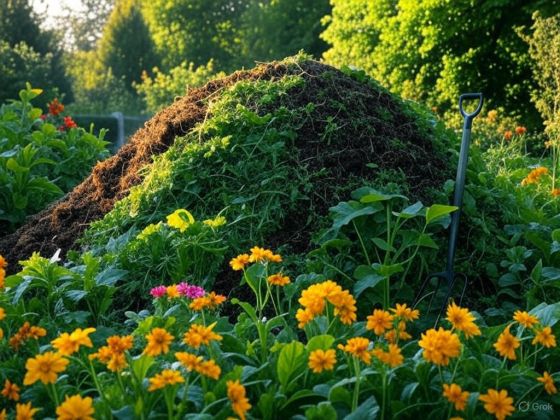Turning you food scraps & yard waste into gold. Composting for first timers and seasoned gardeners as well.
Let It Rot: Turning Scraps into Garden Gold
Let’s talk garbage—specifically, your kitchen scraps. And even more specifically, your fruit and vegetable waste (sorry, no meat allowed, folks!). Composting is the ultimate act of alchemy, transforming what might’ve been trash into rich, soil-building treasure. Whether you’re a newbie gardener or a seasoned green thumb, composting is a rewarding way to nourish your soil and reduce waste.
The title of this blog is also the name of the first composting book I bought over 15 years ago. Published in 1975, Let It Rot! sparked the composting movement and taught gardeners like me how to recycle waste into nutrient-packed compost. With practical advice on starting and maintaining a composting system, building bins, and using the finished product, it’s no wonder this book has sold over 318,000 copies and remains a go-to resource. Its timeless tips still guide my composting journey today.
As my friend Vicki and I discussed on our first show, healthy soil is the foundation of a thriving garden, and making your own compost is one of the best ways to build it. Composting is budget-friendly—using free kitchen scraps from your cooking or canning and yard waste like lawn clippings—and it makes you a steward of the land. By composting, you reduce what ends up in landfills, contributing to a healthier planet. Plus, there’s a deep sense of accomplishment when you create rich, loamy soil with minimal effort. Compost retains moisture, nourishes beneficial soil organisms, and delivers essential nutrients to your garden beds.
Getting Started: Composting Basics for Beginners
Ready to dive in? Composting is simpler than you might think. You’ll need a balance of “greens” (nitrogen-rich materials like fruit scraps, vegetable peels, and fresh grass clippings) and “browns” (carbon-rich materials like dried leaves, cardboard, or straw). Aim for a rough ratio of 3 parts browns to 1 part greens to keep your pile happy and odor-free. Turn your pile every couple of weeks to aerate it, and keep it as moist as a wrung-out sponge. With time and a little care, microbes and worms will work their magic, transforming your waste into dark, crumbly compost.
Pro tip: The smaller you chop your kitchen and yard waste before adding it to your composter, the faster it breaks down. It might feel tedious to mince those carrot peels or shred those branches, but trust me, your patience will be rewarded with quicker, more consistent compost.
What to Compost (and What to Skip)
Compost loves:
- Fruit and veggie scraps (peels, cores, and leftovers)
- Coffee grounds and tea leaves
- Eggshells (crushed for faster breakdown)
- Yard waste like grass clippings, leaves, and small twigs
Avoid:
- Meat, dairy, or oily foods (these attract pests and smell bad)
- Pet waste or diseased plants (they can introduce pathogens)
- Weeds with seeds (unless you want a garden full of them!)
For experienced composters, consider experimenting with less common additions like shredded newspaper, dryer lint, or even small amounts of wood ash (sparingly, as it’s alkaline). Always monitor your pile’s balance to avoid issues.
Choosing a Composting System
Whether you’re a beginner or a compost connoisseur, there’s a setup for you. A simple backyard bin or tumbler works great for most households. Tumblers are especially user-friendly for beginners, as they make turning the pile a breeze. If you’re short on space, try a worm bin for indoor or balcony composting—vermicomposting is a fantastic way to produce high-quality compost in small quantities. For larger gardens, consider a multi-bin system to manage different stages of decomposition. Let It Rot! has excellent DIY bin plans, or you can find ready-made composters online or at garden centers.
Hot Composting: The Fast Track to Finished Compost
For those ready to take composting to the next level, hot composting is a game-changer. Unlike cold composting, which is low-maintenance but slow (taking 6–12 months), hot composting is an active process that can produce finished compost in as little as 4–8 weeks. It’s perfect for experienced gardeners who want faster results or beginners eager to see quick progress.
How Hot Composting Works
Hot composting relies on high temperatures (130–160°F) to accelerate decomposition. These temperatures are driven by microbial activity, which thrives when you provide the right conditions: a balanced mix of greens and browns, adequate moisture, and plenty of oxygen. The heat not only speeds up breakdown but also kills weed seeds and pathogens, resulting in a cleaner final product.
Steps to Hot Compost
- Build a Large Pile: Aim for a pile at least 3x3x3 feet to retain heat. Smaller piles cool too quickly.
- Layer Greens and Browns: Alternate layers of greens and browns, keeping the 3:1 ratio. Mix thoroughly to avoid clumps.
- Moisten the Pile: Add water until the materials are as damp as a wrung-out sponge. Too wet? Add more browns. Too dry? Sprinkle in water.
- Turn Regularly: Turn the pile every 3–5 days to aerate it and maintain heat. Use a pitchfork or shovel to mix the outer materials into the center.
- Monitor Temperature: Use a compost thermometer to check that the pile stays between 130–160°F. If it’s too cool, turn it and add more greens. If it’s too hot (above 160°F), turn it to cool it down.
- Harvest When Ready: The compost is done when it’s dark, crumbly, and smells earthy. Let it cure for 1–2 weeks before using it in your garden.
Tips for Success
- Chop Materials Finely: As with all composting, smaller pieces decompose faster. A lawnmower or shredder can make quick work of yard waste.
- Insulate in Cold Climates: In winter, cover your pile with a tarp or straw to trap heat.
- Be Patient: Hot composting requires more effort, but the payoff is faster, high-quality compost that’s ready to supercharge your garden.
Hot composting is a bit like cooking a gourmet meal—it takes attention and finesse, but the results are worth it. For those who love the science of composting, it’s also a fascinating way to geek out over microbial magic.
Troubleshooting Common Composting Issues
Even experienced composters hit snags. Here are quick fixes for common problems:
- Smelly Pile? Too many greens or too much moisture. Add browns and turn the pile to aerate.
- Slow Decomposition? Check the balance of greens and browns, ensure proper moisture, and chop materials smaller. For hot piles, make sure the temperature is in the right range.
- Pests? Avoid meat, dairy, or oily foods, and bury kitchen scraps deep in the pile. A secure bin or tumbler helps, too.
Why Composting Is Worth It
Composting feels like a small act of rebellion against waste culture. Every banana peel you compost is one less item in a landfill. Every scoop of compost you add to your garden is a step toward healthier soil and more vibrant plants. It’s a cycle that connects you to the earth and leaves you with a sense of pride in your patch of the planet. For experienced gardeners, composting is also a way to fine-tune your soil’s fertility, tailoring it to specific plants or conditions.
So, grab those veggie scraps, fire up your composter, and let it rot! Whether you’re tossing scraps in a tumbler or mastering the art of hot composting, your garden—and the earth—will thank you. What’s your favorite composting tip? Share it below and let’s keep the soil-building love going.








